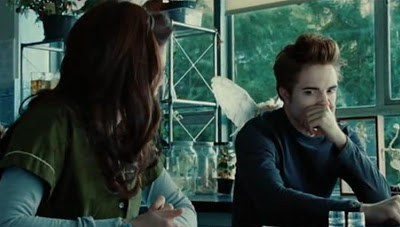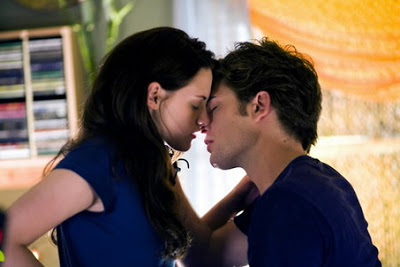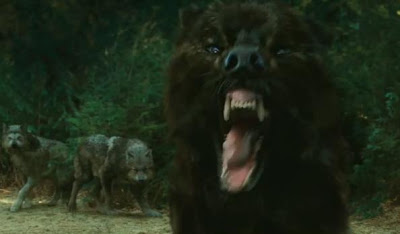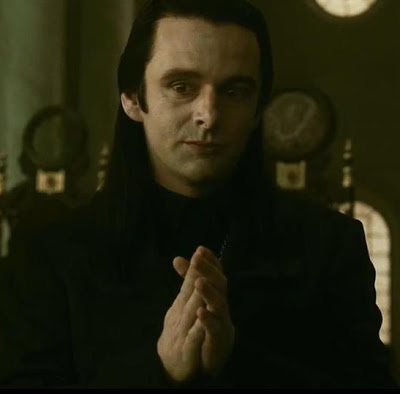“It was pretty terrible. I really enjoyed it.”
That was me, one year ago, on the phone with my father, giving him my brief and not entirely rational assessment of a little movie called Twilight, which has now become America’s latest mega-franchise – the second installment, New Moon, raked in a cool $142.8 million this past weekend, good for third all-time behind The Dark Knight and Spider-Man 3. And while I’m impressed (and more than a tad awed) at the remarkable commercial success of the Twilight films, I have to admit that I’m a little confused as well.
Mainstream movie nut that I am, I’m generally a sucker for the studio-manufactured charms of a big-budget, multi-volume, special-effects-laden blockbuster franchise, but I can’t confess to being a devotee of the Twilight saga. Maybe that’s because it isn’t marketed to my demographic (I am not, in fact, a lovesick teenage girl, despite my occasional indulgence in emotionally devastating female-empowerment pop music). More likely it’s that I haven’t read Stephenie Meyer’s books (partly because I hardly read anything these days, partly because even Meyer’s ardent fans seem to concede that the novels are poorly written). But most of all it’s that, in all honesty, I don’t think the Twilight movies are very good.
Am I being hypocritical? After all, how can I sneer at Twilight when I’m an unabashed fanatic of a bevy of superhero/fantasy/science-fiction franchises, including Harry Potter, Indiana Jones, the Lord of the Rings, the Matrix, Pirates of the Caribbean, Spider-Man, Star Wars, and (most recently) Buffy the Vampire Slayer? But here’s the thing: I actually believe that all of the aforementioned series constitute art, not mere guilty pleasures. I don’t love the Harry Potter movies (and books, of course) because they’re about a boy wizard; I love them because they tell brilliantly plotted adventures involving well-developed characters operating within a fully realized magical universe. The Twilight movies, in contrast, feature goofy dialogue, inane plotting, minimal humor, and a general atmosphere of lunacy. They just aren’t that good.
But just because I didn’t think the first Twilight picture was a good movie didn’t stop me from enjoying the hell out of it. Maybe it’s my weakness for angst-ridden teenagers longing for forbidden love, but the preposterous romance between Bella Swan (played with aplomb by my girl Kristen Stewart) and her vampire beau Edward Cullen (Robert Pattison, who frankly was dreamier when he played Cedric Diggory) was so gleefully over-the-top that it somehow transcended to a ludicrous poetry. For example, I will never forget the pair’s initial meeting, during which Edward eyeballs Bella and is so overcome with desire that he nearly retches. Now that’s love.
To be sure, Twilight was far from perfect, and it indeed crumbled in its final act; you’d think you couldn’t screw up a scene involving rival vampires dueling in a hall of mirrors, but then you’d be underestimating director Catherine Hardwicke’s haplessness when it comes to action scenes. But the movie featured enough giddily blissful moments (nearly) on par with Bella’s and Edward’s “meet cute” that I couldn’t help approaching the screening of New Moon with a surprising degree of anticipation. Because for all Twilight’s flaws, it nevertheless represented one of my more enjoyable times at the movies all of last year.
And maybe that was part of the problem, because damn if the first hour of New Moon isn’t a dreary viewing experience. After a promising early scene in which one of Edward’s de facto brothers gets a whiff of Bella’s blood and nearly exsanguinates her, Edward decides it’s safest for Bella if he abandons her, leaving her to, well, sit around and mope.
And boy can she mope. Inconsolable from the loss of Edward, Bella turns into something of a walking corpse herself, and it’s here where New Moon starts grating. Look, I have nothing against movies that take themselves too seriously – hell, The Dark Knight, one of my favorite films of 2008, took itself pretty damn seriously given that it’s about a billionaire who dresses up as a bat – but their characters need to feel like real people for that seriousness to gain dramatic traction. And while the Twilight movies have their strengths, character realism is not one of them.
More to the point, the central problem with New Moon – and the Twilight saga as a whole, for that matter – is that the all-important romance between Bella and Edward feels illusory. There’s no weight to it, no heft, no sense of actual love. Sure, there are plenty of longing glances and slow-motion sighs, and the pair certainly profess their feelings for each other often enough (not to mention a voiceover in the first film in which Bella conveniently informs us that she’s “unconditionally and irrevocably in love”), but the dialogue is so stilted that it just comes off as playacting. New Moon assumes that, after experiencing the first film, we’ve accepted the lovers’ undying devotion as a given, but love in movies has to be earned, and Twilight never accrued any romantic currency.
Perhaps I’m applying too rigorous a standard to a movie that’s so obviously frivolous, but when you overtly compare your story to that of Romeo and Juliet (and not just once), you’re digging your own grave. I can’t help but feel bad for Bella – woe is the woman caught between warring clans of vampires and werewolves – but it’s more abstract pity than actual empathy. New Moon gamely attempts to introduce a new romantic foil in the form of Jake (played by beefcake Taylor Lautner, and you’ll forgive me if I abstain from the debate about which of Bella’s suitors is more of a stud), but the pairing is too convenient a plot device (and the writing too forced) to generate any true chemistry.
Thus New Moon suffers and simpers its way, and things are going oh-so-miserably (the less said about Bella’s increasingly inane risk-taking attempts in an effort to conjure a disapproving Edward in spectral form, the better), and then … well, then the computer-generated werewolves show up.
Now that’s what I paid to see. Make no mistake, it’s not as if the werewolves are all that visually impressive – no one will suspect Peter Jackson or George Lucas to have been involved in New Moon’s production. Nor do they participate in any particularly suspenseful action sequences. Rather, they signal a certain embrace of absurdity heretofore lacking in the picture, and it’s here that New Moon finally picks up its pace. After the welcome appearance of Alice (an appealing Ashley Greene – keep your eye on her), Bella finds herself flying to Italy in a desperate race to save her beloved (courtesy, it must be said, of an infuriatingly contrived phone call), and for the first time we experience a genuine sense of frisson. Sure, the entire escapade is imbued with a sense of what-the-fuck? style lunacy, but at least it’s interesting.
Besides, that lunacy is partly the point, and it finally recalls the best parts of Twilight. Watching Bella and Alice racing down Italian roads in a gleaming-yellow Porsche toward an ancient cathedral while the hands of a gigantic clock tower move ominously toward noon, I found myself smiling for the first time in the movie.
The freewheeling nature of the film’s second half also allows Chris Weitz (replacing Hardwicke) to liberate himself from the brooding murkiness that dominates the early scenes, and he finally treats us to some memorable images. There’s the red-haired vampire (the sadly underused Victoria) gliding out of the watery shadows like some flaming demonness from Hell. There’s Bella fighting through an army of red-robed acolytes in slow-motion, desperation etched on her face. There’s Bella, in slow-motion yet again, charging through a freaking fountain as that wretched clock keeps moving. None of this is subtle; all of it is fun. (To give credit where it’s due, Weitz also brings some visual pathos to an early moping scene, pulling off a rather lovely circling shot of Bella staring glumly out her window as the months pass by outside.)
More importantly, New Moon’s final set piece – transpiring within an appropriately hallowed cathedral – delights us with the welcome emergence of not one but two terrific actors. The first is Michael Sheen, playing a vampire lord of sorts and having a terrific time doing it. Being a refined British performer hasn’t prevented Sheen from letting loose from time to time (see: the Underworld films), and he seems to be one of the few cast members who recognizes that movies like this exist for the purpose of providing pleasure to the audience (see: Ian McKellen in The Da Vinci Code).
The other actor is a former child star, but I assure you, she is a child no longer. She is, in fact, an unrecognizable Dakota Fanning, and if you’re thinking of her as the cute little girl from War of the Worlds and Dreamer, think again. With pinned-back hair and remorseless red eyes, oozing malevolence without a hint of mercy, she’s all business. Her character seems to have the curious power to take control of another’s senses by uttering a single command. Fanning certainly commands the screen.
And sure, New Moon ends as it must: with a bumbling romantic denouement involving its unsteady, uninteresting triangle. There’s that teenage demographic to appease, of course. No matter. If the final 45 minutes of the movie are any indication, there remains plenty of inanity to absorb, plenty of sublime silliness to sustain me through Bella’s Shakespearean sulking. Those moments make up the true heart of what makes the Twilight films pleasurable, and that’s what they’re all about, after all – extracting the heart from the heartache.
The third installment of the Twilight saga, Eclipse, arrives in theatres on June 30. Time to find a teenage girl to save me a seat.
Jeremy Beck is the editor-in-chief of MovieManifesto. He watches more movies and television than he probably should.





